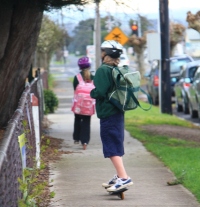Walkable neighbourhoods conquer fears
24 Nov 2015
Trying to reverse the massive decline in kids walking and cycling to school is an exceptionally thorny problem. While there are a lot of factors at play, it is clear that parents' fear for the safety of their children, especially 'stranger danger,' is a major hurdle. But how do you overcome something that is based on media reports of exceptionally rare events rather than the practical reality that Australian streets are generally very safe?
The answer seems to have been provided by the study Suspicious minds: Can features of the local neighbourhood ease parents' fears about stranger danger?
Based on a survey of 1,245 parents living in Perth, the research looked at a wide range of factors influencing parents' attitudes.
Many of the factors that emerged as influencing parental fear don't necessarily lend themselves to change. Parents who were older, more educated, lived in their neighbourhood for longer and had boys, were less fearful of strangers. Parents with greater awareness of media reports relating to stranger danger were more fearful.
However, two factors relating to the urban environment stood out as things we can change. Parents who saw their neighbourhood as "an inviting pedestrian environment (i.e., more pedestrians in a pleasing, friendly setting)" were less fearful, whereas perceptions of more vehicle traffic led parents to be more fearful of strangers.
This finding that more traffic makes parents more fearful of strangers is not necessarily logical, but it is not surprising that parents don't always make a clear distinction between the sources of danger in the neighbourhood. It raises the prospect that improving road safety around schools will have a double benefit for parental attitudes - not only will they see less risk from traffic, they will see less risk from strangers too. Improving road safety could also start a virtuous cycle - if it leads some parents to let their children walk or bike to school, the perception of 'safety in numbers' is likely to see more parents follow their lead.
It's critical that we get this right, because kids that walk to school have so many advantages over those who don't. As the authors of this study note, "paradoxically, parents desire to keep their children safe from harm can have unintended negative consequences for children's physical and psychological health."
The fact that more pedestrian friendly neighbourhoods are perceived as safer by parents is not really surprising. And it brings us full circle - if we want more children walking to school, we need to build communities where it is easier and more attractive to walk for everyone.
More information
Suspicious minds: Can features of the local neighbourhood ease parents' fears about stranger danger? by S. Foster, L. Wood, J Francis, M Knuiman,K. Villanueva and B. Giles-Corti is reported in Phys.org and a number of academic journals, but availability of full text depends on institutional rights or payment.